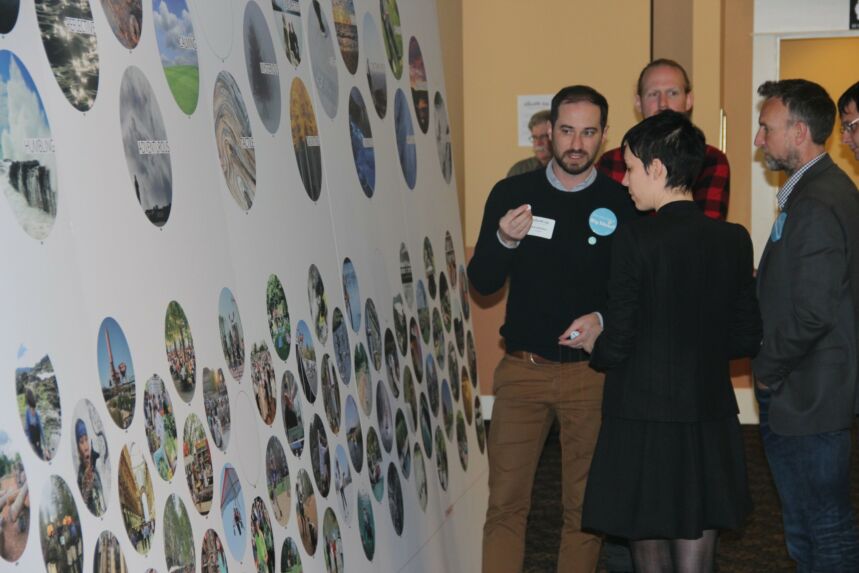March 19, 2019
Stuckeman alumni work together at renowned design firm in New York, Part 1

Landscape architect makes a name for himself designing post-industrial sites at Snøhetta
Matt McMahon and Adam Longenbach, two Penn State alumni from the Stuckeman School, are working together in New York City at Snøhetta, an internationally-renowned practice of architecture, landscape architecture, interior architecture, product and graphic design. McMahon, a 2004 graduate with bachelor’s degrees in landscape architecture and biology, and Longenbach, who graduated in 2011 with master’s and bachelor’s degrees in architecture, have found comfort in sharing the workplace with someone not only from the same alma mater, but also from the same home state of Pennsylvania.
McMahon grew up in the north hills of Pittsburgh with his mom, who was a school teacher, and dad, who worked in the natural gas industry. His upbringing in the waning industrial Pittsburgh of the 1980s gave him an appreciation of the value industrial sites hold. Uncles and cousins who had worked in the declining steel industry shared stories of the mills and coal barges, and his father spoke of scrubbing coke ovens as a summer job. His family instilled the significance that industrial sites had to their workers; ugly, environmentally harmful sites may also be places of collective memory and identity. This thought has become a theme in his career as many of his projects fall upon sites where industry has been abandoned.
McMahon initially came to Penn State to major in biology with the intent of pursuing a career in medicine; however, after taking Bonj Szczygiel’s course on the history of landscape architecture, he became fascinated with the subject. Dan Jones, Tim Baird and Sam Dennis, who were members of the Department of Landscape Architecture faculty at the time, helped him grow his interest in design and revealed the opportunities that were possible as a landscape architect.
“With landscape architecture, I realized that I would be able to improve the lives of people and the environment in our cities, and simultaneously convey cultural value and meaning,” said McMahon.
With a year of hard sciences under his belt, he decided to double major in biology and landscape architecture. Highlights of his time at Penn State included a semester abroad in Rome focusing on renaissance gardens and plazas, tropical ecology coursework in Costa Rica, summers learning about plant taxonomy and ecology in central Pennsylvania and two Honors College-funded internships with Hargreaves Associates in Cambridge.
After graduation, he moved to New York City to work for both Michael Van Valkenburgh Associates (MVVA) and an applied ecology firm, Great Eastern Ecology. At these firms, he worked on significant post-industrial site projects along the abandoned piers of New York’s waterfront, converting them into public space and habitat. Two of the most notable projects McMahon worked on during this time were Segment Five of the Hudson River Park and the Brooklyn Bridge Park. Both projects won national awards of excellence from the American Society of Landscape Architects and allowed him to act as a liaison between scientists and designers.
“I was taking my ability to understand the language of ecology and working with my scientist peers translating it to help architects and landscape architects create a diversity of habitats in the New York City region,” he said.
During his time at these different companies, McMahon found himself working on several projects that involved unorthodox landscapes.
“Often times we were working on a rooftop, landfill or pier and the ground was far more complex than what landscape architects traditionally dealt with,” he said. “We had to engage with structure and architecture in a way that was unexpected.”
This realization has propelled his career forward. Since his early years in New York, McMahon has gone on to earn a Master of Architecture degree from Princeton University, take a position at Stan Allen and Grimshaw Architect and he is now is helping lead landscape design at Snøhetta’s New York office.
“Snøhetta is a unique practice in that it brings together many different professions under one roof and is very open in how it engages clients and the public as part of its design process.” he said.
McMahon’s major project at Snøhetta, Willamette Falls Riverwalk, demonstrates this process and ties back to his early motivations regarding industrial sites. The project seeks to rediscover a major waterfall on the Willamette River in Oregon, buried by a century of industrial developments. The public process he managed engaged thousands of Oregonians at public meetings and balanced the competing needs of an active power company, five confederated tribes, four levels of government, a private landowner, historic preservations and endangered species advocates.
“I get to be my full professional and academic self on the project – all aspects of my background are in demand as we collaborate with landscape architects, architects, hydrologists, ecologists and engineers to carefully edit the constructed site and balance the needs of stakeholders,” said McMahon.
Other major highlights of McMahon’s career at Snøhetta include the recently opened Calgary Public Library, which was featured in The New York Times, and running a vision and masterplan process for Vesterheim Norwegian-American Museum in Decorah, Iowa.
McMahon helps manage the overall landscape team and occasionally collaborates on competitions and project pursuits with Longenbach, who is on the acquisitions and company strategy team. Part two of this series will focus on Longenbach and his many accomplishments as an architect at Snøhetta.
